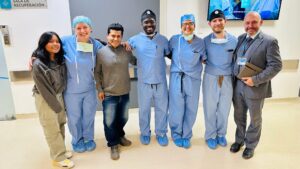Post-infarct ventricular septal defect (VSD) is a rare but life-threatening complication of acute myocardial infarction (AMI), leading to abnormal communication between the left and right ventricles. Despite advancements in treatment, this condition carries a high risk of mortality, particularly in cases complicated by cardiogenic shock. Surgical repair, while essential, often yields better outcomes when delayed to allow tissue stabilization. However, patients in unstable hemodynamic states require mechanical circulatory support (MCS) to bridge the period until intervention. This systematic review evaluates the role of the Impella, a micro-axial flow pump, in stabilizing patients prior to definitive VSD repair.
A comprehensive search of Medline and EMBASE identified 20 studies encompassing 68 patients. The included studies primarily consisted of case reports and series, reflecting the rarity of this clinical scenario. Patients’ ages ranged from 45 to 79, with more than 95% presenting in cardiogenic shock. The culprit lesion was predominantly the right coronary artery (58%), and 62% of VSDs were posterior, which correlates with a worse prognosis. Most patients underwent surgical (60%) or percutaneous (12%) repair, while others received heart transplantation or medical management.
The Impella device, available in both percutaneous (2.5 or CP) and surgical (5.0 or 5.5) versions, was used as a bridge to intervention. It operates by unloading the left ventricle (LV), reducing intracardiac pressures, and improving systemic perfusion. The device also reduces the left-to-right shunting seen in VSD, stabilizing hemodynamics and mitigating end-organ dysfunction caused by low cardiac output syndrome. This stabilization is particularly critical for delaying surgical repair until myocardial tissue has sufficiently fibrosed, providing a more robust substrate for repair.
Outcomes revealed an overall in-hospital mortality of 47%. Importantly, patients who achieved surgical or percutaneous VSD closure had better outcomes (30% mortality) compared to those managed medically. Notably, patients with surgically-implanted Impella devices demonstrated superior outcomes compared to percutaneous devices, with mortality rates of 35% versus 58%. Surgical devices also allowed for longer support durations (up to 52 days) and exhibited lower rates of complications such as bleeding (20% vs. 35%) and acute limb ischemia.
The review highlights key challenges associated with Impella use in VSD patients. One major concern is the potential inversion of the shunt flow from left-to-right to right-to-left due to excessive LV unloading, which can result in systemic hypoxemia. This complication necessitates careful titration of Impella flow, often requiring concomitant use of veno-arterial extracorporeal membrane oxygenation (VA-ECMO) in an “ECMELLA” configuration. ECMELLA, combining Impella for LV unloading and ECMO for right ventricular (RV) support, provides total circulatory support, particularly in cases of severe biventricular dysfunction.
Common complications associated with the Impella included major bleeding (24%), hemolysis (9%), acute limb ischemia (6%), and device dysfunction (4%). These issues underscore the importance of careful monitoring and device management. Surgical implantation appears to mitigate some risks, offering longer support durations and fewer adverse events.
The findings suggest that the Impella is an effective MCS option for patients with post-infarct VSD, particularly in those with isolated LV dysfunction or mild RV compromise. By improving hemodynamics and stabilizing patients, the device facilitates delayed repair, which is associated with improved surgical outcomes. In cases of severe biventricular dysfunction, the combination of Impella and ECMO (ECMELLA) offers comprehensive support.
However, this review has limitations, including the predominance of case reports and small series, which restricts generalizability and precludes meta-analysis. Selection and publication biases may also favor successful outcomes. Further research, particularly comparative studies, is needed to validate these findings and optimize MCS strategies for post-infarct VSD.
In conclusion, the Impella serves as a valuable tool in the pre-procedural management of post-infarct VSD, offering hemodynamic stabilization and improving outcomes when definitive repair is delayed. While complications remain a concern, particularly with percutaneous devices, surgical implantation appears to enhance safety and effectiveness.







